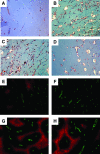Inhibition of tumor endothelial ERK activation, angiogenesis, and tumor growth by sorafenib (BAY43-9006)
- PMID: 17071608
- PMCID: PMC1780219
- DOI: 10.2353/ajpath.2006.050711
Inhibition of tumor endothelial ERK activation, angiogenesis, and tumor growth by sorafenib (BAY43-9006)
Abstract
Activation of the Raf-MEK-ERK signal transduction pathway in endothelial cells is required for angiogenesis. Raf is the kinase most efficiently inhibited by the multikinase inhibitor sorafenib, which has shown activity against certain human cancers in clinical trials. To understand the mechanisms underlying this activity, we studied how it controlled growth of K1735 murine melanomas. Therapy caused massive regional tumor cell death accompanied by severe tumor hypoxia, decreased microvessel density, increased percentage of pericyte-covered vessels, and increased caliber and decreased arborization of vessels. These signs of K1735 angiogenesis inhibition, along with its ability to inhibit Matrigel neovascularization, showed that sorafenib is an effective anti-angiogenic agent. Extracellular signal-regulated kinase (ERK) activation in tumor endothelial cells, revealed by immunostaining for phospho-ERK and CD34, was inhibited, whereas AKT activation, revealed by phospho-AKT immunostaining, was not inhibited in K1735 and two other tumor types treated with sorafenib. Treatment decreased endothelial but not tumor cell proliferation and increased both endothelial cell and tumor cell apoptosis. These data indicate that sorafenib's anti-tumor efficacy may be primarily attributable to angiogenesis inhibition resulting from its inhibition of Raf-MEK-ERK signaling in endothelial cells. Assessing endothelial cell ERK activation in tumor bio-psies may provide mechanistic insights into and allow monitoring of sorafenib's activity in patients in clinical trials.
Figures






Similar articles
-
Sorafenib blocks the RAF/MEK/ERK pathway, inhibits tumor angiogenesis, and induces tumor cell apoptosis in hepatocellular carcinoma model PLC/PRF/5.Cancer Res. 2006 Dec 15;66(24):11851-8. doi: 10.1158/0008-5472.CAN-06-1377. Cancer Res. 2006. PMID: 17178882
-
Tie2 in tumor endothelial signaling and survival: implications for antiangiogenic therapy.Mol Cancer Res. 2009 Mar;7(3):300-10. doi: 10.1158/1541-7786.MCR-08-0215. Epub 2009 Mar 10. Mol Cancer Res. 2009. PMID: 19276184 Free PMC article.
-
Induction of Bim expression contributes to the antitumor synergy between sorafenib and mitogen-activated protein kinase/extracellular signal-regulated kinase kinase inhibitor CI-1040 in hepatocellular carcinoma.Clin Cancer Res. 2009 Sep 15;15(18):5820-8. doi: 10.1158/1078-0432.CCR-08-3294. Epub 2009 Sep 8. Clin Cancer Res. 2009. PMID: 19737956
-
Role of Raf kinase in cancer: therapeutic potential of targeting the Raf/MEK/ERK signal transduction pathway.Semin Oncol. 2006 Aug;33(4):392-406. doi: 10.1053/j.seminoncol.2006.04.002. Semin Oncol. 2006. PMID: 16890795 Review.
-
Raf kinase as a target for anticancer therapeutics.Mol Cancer Ther. 2005 Apr;4(4):677-85. doi: 10.1158/1535-7163.MCT-04-0297. Mol Cancer Ther. 2005. PMID: 15827342 Review.
Cited by
-
Sorafenib treatment for papillary thyroid carcinoma with diffuse lung metastases in a child with autism spectrum disorder: a case report.BMC Cancer. 2017 Nov 21;17(1):775. doi: 10.1186/s12885-017-3782-7. BMC Cancer. 2017. PMID: 29162036 Free PMC article.
-
Trans-3,4,5,4'-tetramethoxystilbene, a resveratrol analog, potently inhibits angiogenesis in vitro and in vivo.Acta Pharmacol Sin. 2013 Sep;34(9):1174-82. doi: 10.1038/aps.2013.60. Epub 2013 Jun 17. Acta Pharmacol Sin. 2013. PMID: 23770989 Free PMC article.
-
Erk1 and Erk2 regulate endothelial cell proliferation and migration during mouse embryonic angiogenesis.PLoS One. 2009 Dec 14;4(12):e8283. doi: 10.1371/journal.pone.0008283. PLoS One. 2009. PMID: 20011539 Free PMC article.
-
Genetic Variants of VEGFA and FLT4 Are Determinants of Survival in Renal Cell Carcinoma Patients Treated with Sorafenib.Cancer Res. 2019 Jan 1;79(1):231-241. doi: 10.1158/0008-5472.CAN-18-1089. Epub 2018 Nov 1. Cancer Res. 2019. PMID: 30385613 Free PMC article. Clinical Trial.
-
Tumorigenesis of papillary thyroid cancer is not BRAF-dependent in patients with acromegaly.PLoS One. 2014 Oct 17;9(10):e110241. doi: 10.1371/journal.pone.0110241. eCollection 2014. PLoS One. 2014. PMID: 25329702 Free PMC article.
References
-
- Almoguera C, Shibata D, Forrester K, Martin J, Arnheim N, Perucho M. Most human carcinomas of the exocrine pancreas contain mutant c-K-ras genes. Cell. 1988;53:549–554. - PubMed
-
- Forrester K, Almoguera C, Han K, Grizzle WE, Perucho M. Detection of high incidence of K-ras oncogenes during human colon tumorigenesis. Nature. 1987;327:298–303. - PubMed
-
- Bos JL, Fearon ER, Hamilton SR, Verlaan-de Vries M, van Boom JH, van der Eb AJ, Vogelstein B. Prevalence of ras gene mutations in human colorectal cancers. Nature. 1987;327:293–297. - PubMed
-
- Bos JL. Ras oncogenes in human cancer: a review. Cancer Res. 1989;49:4682–4689. - PubMed
-
- Brose MS, Volpe P, Feldman M, Kumar M, Rishi I, Gerrero R, Einhorn E, Herlyn M, Minna J, Nicholson A, Roth JA, Albelda SM, Davies H, Cox C, Brignell G, Stephens P, Futreal PA, Wooster R, Stratton MR, Weber BL. BRAF and RAS mutations in human lung cancer and melanoma. Cancer Res. 2002;62:6997–7000. - PubMed
Publication types
MeSH terms
Substances
Grants and funding
LinkOut - more resources
Full Text Sources
Other Literature Sources
Medical
Research Materials
Miscellaneous

